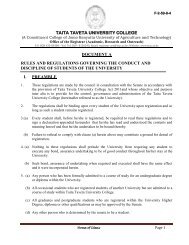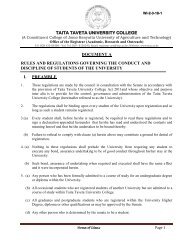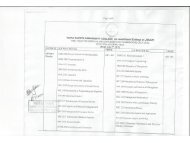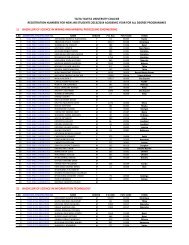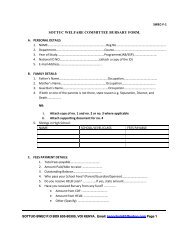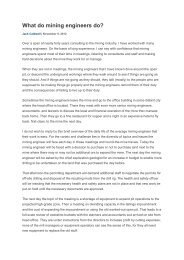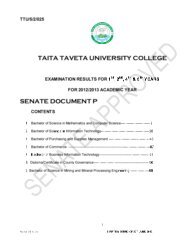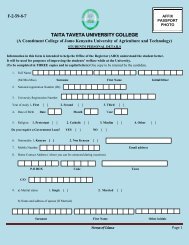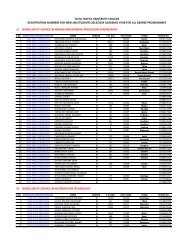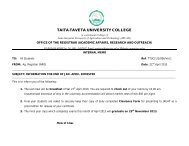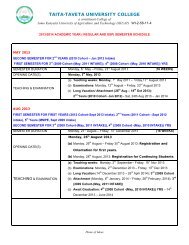Conference Book of Abstracts - Taita Taveta University College
Conference Book of Abstracts - Taita Taveta University College
Conference Book of Abstracts - Taita Taveta University College
- No tags were found...
You also want an ePaper? Increase the reach of your titles
YUMPU automatically turns print PDFs into web optimized ePapers that Google loves.
Development and Assessment <strong>of</strong> Technologies for Exploration <strong>of</strong> Genomic and MetaboliteDiversity <strong>of</strong> extremophiles from Kenyan Soda LakesFrancis J. Mulaa, Biochemistry Department, Faculty <strong>of</strong> Medicine, <strong>University</strong> <strong>of</strong> Nairobimulaafj@uonbi.ac.keThe study highlights, technologies aimed at the mining <strong>of</strong> enzymes and metabolic pathways fromextremophilic organisms and metagenomes from microbial communities from peculiar sodalakes environments and consequent funneling the new enzymatic reactions and processestowards new biotechnological applications are. The technologies are build up on the scientificand technological application <strong>of</strong> the state-<strong>of</strong>-the-art technologies for archiving, molecularactivity screening, enzyme engineering and directed evolution and establishing newbiotechnological processes including biocatalysis and pathway engineering for the synthesis <strong>of</strong>fine chemicals. The central approach <strong>of</strong> the biocatalysis and metabolic engineering is based onthe “Activity First” principle, allowing to directly access metabolic reactions <strong>of</strong> biotechnologicalrelevance. This approach contrasts with the massive sequencing and consequent“genome/metagenome gazing” approach which can only reveal those genes encoding theenzymes <strong>of</strong> already known protein families. Designed and/or directed evolution methods areemployed to improve the performance and specificity <strong>of</strong> the enzymes. A comprehensivebioinformatic approach throughout the whole tree <strong>of</strong> cellular life is used to suggest newcandidates homologous to the discovered new proteins, from other organisms to be cloned andassayed.Amongst other highlights include: Molecular methods to identify and quantify bacteria witheconomic potential directly in any given soil sample and to assess their state <strong>of</strong> activity. Wecombine quantitative PCR and DNA-chip technology to retrieve specific gene sequences andassess their amounts in soil samples. 16S rRNA sequences serve to identify species.The studies also show the development <strong>of</strong> a versatile fermentation platform, using the oleaginousyeastYarrowialipolytica, for the conversion <strong>of</strong> lipid feedstocks into diverse added-valueproducts. Relevant enzymatic properties for the production <strong>of</strong> compounds <strong>of</strong> interest are derivedfrom marine hydrocarbonoclastic bacteria. Research directed at elucidating the lipid metabolism<strong>of</strong> the yeast, together with available genomic data make it possible to intercept its lipidmetabolism for biotechnological purposes.Genomic and phenotypic analyses are performed to characterize the new species and to allowreliable identification. The geographical dissemination <strong>of</strong> extremophiles strains can be monitoredby 16S rRNA directly extracted from soil samples. The presence <strong>of</strong> soda lakes bacteria will beunveiled by cloning and sequencing <strong>of</strong> PCR-amplified 16S rDNA. Their species richness andabundance in microbial communities <strong>of</strong> different environmental soils will be spatially monitoredby 16S rDNA analysis. We show how extremophile strains recalcitrant to cultivation can beenriched by cell sorting methods. The show how specialised high-throughput screening for novel



